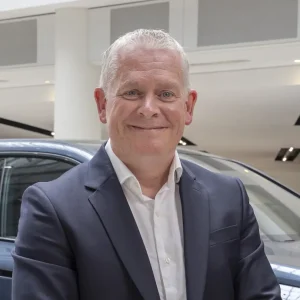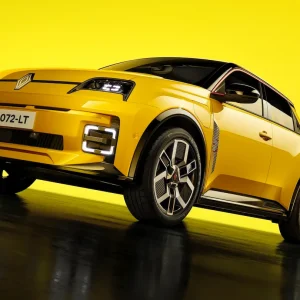A pair of new model launches is only the start for Fiat Group’s trio of mainstream car brands, as new fleet boss Francis Bleasdale tells Paul Barker.
Fiat, the company’s fleet and used car director Francis Bleasdale admits, is a company that has previously been seen in the industry as having an inconsistent approach to the corporate sector, but a couple of business-friendly new models are leading the change towards a more balanced plan.
“It’s fair to say that if you speak to people in the industry, the group is seen as one that’s in and out – were we truly serious about fleet?” Bleasdale tells BusinessCar. “Now we are unequivocally serious and starting to lay the foundations ahead of a great push this year and in succeeding years.”
Bleasdale was appointed to lead Fiat Group’s fleet and used vehicle activity across its car brands, primarily Fiat, Alfa Romeo and Jeep, in August 2014, having previously served more than nine years at Nissan, most recently as LCV sales and marketing director for Nissan UK, and as fleet and used car manager for Nissan Europe.
“We’re seen at a very basic level as a heavily retail business,” he declares, quoting the figure of fleet accounting for 35% of the firm’s registrations, against a broadly 50:50 industry average, but says two new models will help bring that to around 48% this year.
The Jeep Renegade and its Fiat 500X sister vehicle enter the flourishing small crossover sector in February and April respectively, with the Renegade offering a 120g/km model and the 500X getting down to a low of 109g/km.
“We need to deliver a top-class launch into the fleet industry, make sure we get the communication message right, [and have] the right product specced correctly at the right time,” continues Bleasdale, who also points out that Fiat Group has recently launched a three-day test drive programme to help “try and connect with user-choosers in a more meaningful way”, while in 2014 it expanded its demo fleet with more Alfa Romeo Giulietta and Jeep Cherokee models.
The 500X and Renegade will expand the demonstration model numbers further this year, and the corporate team under Bleasdale grew from 16 to 25 people last year ahead of the predicted fleet registration growth of around 12,000 units for the group in 2015.
That growth will come in what he calls a “managed” way. “We’re not going to say we will pull out of daily rental and cut back on certain channels. We have a balanced approach to the market and there is a quantity of daily rental designated for us to achieve to help product exposure and [nearly new] cars for retail,” he says. “It’s about doing that side of the business well.”
Motability is another area in which the company is looking for a more consistent approach. “We were in and out of Motability and never took a conscious decision that we would have an ongoing presence in that marketplace,” Bleasdale continues. “We’re here and ready for business. We’re not going to throw the book at certain parts of the industry, we’re looking to build and grow in a balanced and sustained way. If we’re saying we’ll do something then we’ll do it; if we’re not then we won’t.”
Residuals and running costs are also under renewed scrutiny as the brand tries to increase its business
car presence.
“Am I ever satisfied with where we are with RVs? Probably not,” says Fiat’s fleet boss. “With the 500 you have a great product, marketed really well, doing business in a responsible and sustainable way and growing naturally. It proves we can manage such business responsibly and is a template for everything else we do going forward.”
The UK operation is also having conversations with its Italian headquarters regarding improvements to SMR cost. Other work on Bleasdale’s plate includes a rebranding of the group’s used car operation to encompass all three brands, and the potential to increase the number of small fleet specialist dealers from 26 to around 40.
Bleasdale admits that bringing together the three very different brands of Fiat, Alfa Romeo and Jeep is not the easiest of tasks. “We have a much more comprehensive and cohesive range than people think,” he says. “Yes, there’s a challenge, but one we can explain, and from talking to customers we find an enormous level of awareness of these brands and genuine warmth towards them. There’s a desire to see Fiat, Alfa and Jeep succeed, and we’ll do that by showing we’re serious and credible players in the industry.”
Fixing Alfa
Fiat Group’s fleet and used car director Francis Bleasdale admits that the premium Alfa Romeo brand hasn’t had the best of times recently in the fleet sector, but says it is about to turn a corner. “We’re going to fix Alfa, which has really been treading water from a fleet perspective, and will have the product to take it into the upper medium segment [in 2016]”, he says. “We, previously, have not done as good a job as we should have done in building awareness and building volume of the Giulietta. It’s a great alternative to established C-segment cars.”
He says the new Business Edition trim, that offers fleet-friendly equipment such as metallic paint, satnav and parking sensors, can “give people a compelling reason to look again at Alfa”.
“In this day of conformity and uniform choice lists, it represents something different for someone on their second or third iteration of a German brand,” Bleasdale continues. “Historically, Alfa has not punched at its weight. The 156 and 159 models clearly were at a certain point in time, but as these products ceased to be, Alfa has not been able to do that.”
But while Alfa Romeo is in line for a boost when the new upper medium saloon arrives next year, notable by its absence was any talk about the Chrysler brand, which has been subject to reports that the two remaining models, the Ypsilon supermini and executive 300C, will be deleted from sale in the UK.
“The cars are still available through dealers – it’s something for the future,” says a spokesman. “They’re still part of the offer and available. We’ve got to look at what we have got across the group. Things are going to change and evolve.”





